当前位置:
X-MOL 学术
›
Chem. Res. Toxicol.
›
论文详情
Our official English website, www.x-mol.net, welcomes your
feedback! (Note: you will need to create a separate account there.)
A Case Study with Triazole Fungicides to Explore Practical Application of Next-Generation Hazard Assessment Methods for Human Health.
Chemical Research in Toxicology ( IF 3.7 ) Pub Date : 2020-02-26 , DOI: 10.1021/acs.chemrestox.9b00484 Leo T M van der Ven , Emiel Rorije , R Corinne Sprong , Daniele Zink , Remco Derr 1 , Giel Hendriks 1 , Lit-Hsin Loo , Mirjam Luijten
Chemical Research in Toxicology ( IF 3.7 ) Pub Date : 2020-02-26 , DOI: 10.1021/acs.chemrestox.9b00484 Leo T M van der Ven , Emiel Rorije , R Corinne Sprong , Daniele Zink , Remco Derr 1 , Giel Hendriks 1 , Lit-Hsin Loo , Mirjam Luijten
Affiliation

|
The ongoing developments in chemical risk assessment have led to new concepts building on integration of sophisticated nonanimal models for hazard characterization. Here we explore a pragmatic approach for implementing such concepts, using a case study of three triazole fungicides, namely, flusilazole, propiconazole, and cyproconazole. The strategy applied starts with evaluating the overall level of concern by comparing exposure estimates to toxicological potential, followed by a combination of in silico tools and literature-derived high-throughput screening assays and computational elaborations to obtain insight into potential toxicological mechanisms and targets in the organism. Additionally, some targeted in vitro tests were evaluated for their utility to confirm suspected mechanisms of toxicity and to generate points of departure. Toxicological mechanisms instead of the current "end point-by-end point" approach should guide the selection of methods and assays that constitute a toolbox for next-generation risk assessment. Comparison of the obtained in silico and in vitro results with data from traditional in vivo testing revealed that, overall, nonanimal methods for hazard identification can produce adequate qualitative hazard information for risk assessment. Follow-up studies are needed to further refine the proposed approach, including the composition of the toolbox, toxicokinetics models, and models for exposure assessment.
中文翻译:

以三唑类杀菌剂为例,探讨下一代危害人类健康的评估方法的实际应用。
化学危险性评估的不断发展导致了新的概念的建立,这些概念建立在复杂的非动物模型用于危险性表征的集成上。在这里,我们通过对三种三唑类杀菌剂(氟硅唑,丙环唑和环丙唑)的案例研究,探索了实现此类概念的实用方法。所采用的策略始于通过比较暴露估计值与毒理学潜力来评估总体关注程度,然后结合计算机分析工具和文献衍生的高通量筛选分析方法以及计算方法,以深入了解毒理学中潜在的毒理学机制和目标生物。此外,还评估了一些有针对性的体外测试的效用,以确认可疑的毒性机制并产生出发点。毒理学机制应代替当前的“逐点研究”方法,指导选择构成下一代风险评估工具箱的方法和测定。将获得的计算机模拟结果和体外结果与传统的体内测试数据进行比较后发现,总体而言,非动物性危害识别方法可为风险评估提供足够的定性危害信息。需要进行后续研究以进一步完善提议的方法,包括工具箱的组成,毒物动力学模型和暴露评估模型。将获得的计算机模拟结果和体外结果与传统的体内测试数据进行比较后发现,总体而言,非动物性危害识别方法可为风险评估提供足够的定性危害信息。需要进行后续研究以进一步完善提议的方法,包括工具箱的组成,毒物动力学模型和暴露评估模型。将获得的计算机模拟结果和体外结果与传统的体内测试数据进行比较后发现,总体而言,非动物性危害识别方法可为风险评估提供足够的定性危害信息。需要进行后续研究以进一步完善提议的方法,包括工具箱的组成,毒物动力学模型和暴露评估模型。
更新日期:2020-02-27
中文翻译:

以三唑类杀菌剂为例,探讨下一代危害人类健康的评估方法的实际应用。
化学危险性评估的不断发展导致了新的概念的建立,这些概念建立在复杂的非动物模型用于危险性表征的集成上。在这里,我们通过对三种三唑类杀菌剂(氟硅唑,丙环唑和环丙唑)的案例研究,探索了实现此类概念的实用方法。所采用的策略始于通过比较暴露估计值与毒理学潜力来评估总体关注程度,然后结合计算机分析工具和文献衍生的高通量筛选分析方法以及计算方法,以深入了解毒理学中潜在的毒理学机制和目标生物。此外,还评估了一些有针对性的体外测试的效用,以确认可疑的毒性机制并产生出发点。毒理学机制应代替当前的“逐点研究”方法,指导选择构成下一代风险评估工具箱的方法和测定。将获得的计算机模拟结果和体外结果与传统的体内测试数据进行比较后发现,总体而言,非动物性危害识别方法可为风险评估提供足够的定性危害信息。需要进行后续研究以进一步完善提议的方法,包括工具箱的组成,毒物动力学模型和暴露评估模型。将获得的计算机模拟结果和体外结果与传统的体内测试数据进行比较后发现,总体而言,非动物性危害识别方法可为风险评估提供足够的定性危害信息。需要进行后续研究以进一步完善提议的方法,包括工具箱的组成,毒物动力学模型和暴露评估模型。将获得的计算机模拟结果和体外结果与传统的体内测试数据进行比较后发现,总体而言,非动物性危害识别方法可为风险评估提供足够的定性危害信息。需要进行后续研究以进一步完善提议的方法,包括工具箱的组成,毒物动力学模型和暴露评估模型。







































 京公网安备 11010802027423号
京公网安备 11010802027423号